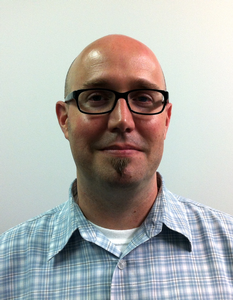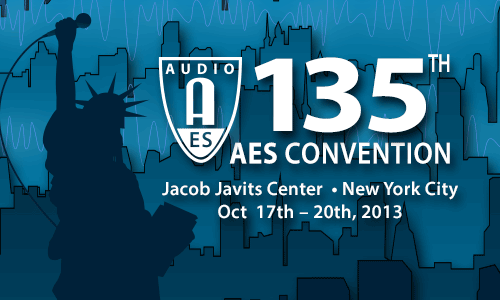
AES New York 2013
Networked Audio Track Event Details
Thursday, October 17, 2:30 pm — 4:30 pm (Room 1E12)
Live Sound Seminar: LS2 - Audio Network and Transport
Chair:Jim Risgin, On Stage Audio - Wood Dale, IL, USA
Panelists:
Mark Dittmar, Firehouse Productions
Phil Reynolds, System Tech, The Killers
Robert Silfvast, Avid - Mountain View, CA, USA
Abstract:
As audio and control over network become more predominate in today’s live sound environment managing the network becomes more challenging. This panel will discuss the problems, challenges, and solutions required that are associated with sharing the bandwith between audio and control as well as the unique challenges created by all the different manufacturers and protocols. Our discussion will rely heavily upon questions and comments from the audience as your experiences, pitfalls and questions are central to these common challenges today.
Thursday, October 17, 4:30 pm — 6:00 pm (Room 1E13)
Networked Audio: N1 - One Network to Rule Them All
Chair:Kevin Gross, AVA Networks - Boulder, CO, USA
Panelists:
Mattias Allevik, Video Corporation of America - New York, NY, USA
Dave Revel, Technical Multimedia Design, Inc. - Burbank, CA, USA
Abstract:
Networked audio distribution is now less frequently accomplished as a separate infrastructure. The promise of running audio on the same network as other facility services and applications is now coming to fruition. This workshop will discuss the motivation for combining services, the challenges in doing so, and requirements this approach puts on audio networking technologies.
 | This session is presented in association with the AES Technical Committee on Network Audio Systems |
Thursday, October 17, 6:00 pm — 7:00 pm (Room 1E13)
Networked Audio: N2 - A Primer on Fundamental Concepts of Media Networking
Presenter:Landon Gentry, Audinate - Portland, OR, USA; Sydney, Australia
Abstract:
This session will cover the OSI model and how data travels through network layers (a “networking stack”): Layers 1, 2, 3 and 4; Cables, MAC Addresses, IP Addresses, and networking protocols. An overview of some networking standards and standards organizations, including the IEEE and the IETF. An introduction to IP data networking . . . it is how everything is already wired together. Identify some of the advantages and limitations of IP data networks with respect to real-time media. A brief discussion of IP networking standards and protocols that can be leveraged for media networking.
Friday, October 18, 9:00 am — 11:30 am (Room 1E09)
Paper Session: P9 - Applications in Audio—Part I
Chair:
Sungyoung Kim, Rochester Institute of Technology - Rochester, NY, USA
P9-1 Audio Device Representation, Control, and Monitoring Using SNMP—Andrew Eales, Wellington Institute of Technology - Wellington, New Zealand; Rhodes University - Grahamstown, South Africa; Richard Foss, Rhodes University - Grahamstown, Eastern Cape, South Africa
The Simple Network Management Protocol (SNMP) is widely used to configure and monitor networked devices. The architecture of complex audio devices can be elegantly represented using SNMP tables. Carefully considered table indexing schemes support a logical device model that can be accessed using standard SNMP commands. This paper examines the use of SNMP tables to represent the architecture of audio devices. A representational scheme that uses table indexes to provide direct-access to context-sensitive SNMP data objects is presented. The monitoring of parameter values and the implementation of connection management using SNMP are also discussed.
Convention Paper 8962 (Purchase now)
P9-2 IP Audio in the Real-World; Pitfalls and Practical Solutions Encountered and Implemented when Rolling Out the Redundant Streaming Approach to IP Audio—Kevin Campbell, WorldCast Systems /APT - Belfast, N Ireland; Miami, Florida
This paper will review the development of IP audio links for audio delivery and chiefly look at the possibility of harnessing the flexibility and cost-effectiveness of the public internet for professional audio delivery. We will discuss first the benefits of IP audio when measured against traditional synchronous audio delivery and also the typical problems associated with delivering real-time broadcast audio across packetized networks, specifically in the context of unmanaged IP networks. The paper contains an examination of some techniques employed to overcome these issues with an in-depth look at the redundant packet streaming approach.
Convention Paper 8963 (Purchase now)
P9-3 Implementation of AES-64 Connection Management for Ethernet Audio/Video Bridging Devices—James Dibley, Rhodes University - Grahamstown, South Africa; Richard Foss, Rhodes University - Grahamstown, Eastern Cape, South Africa
AES-64 is a standard for the discovery, enumeration, connection management, and control of multimedia network devices. This paper describes the implementation of an AES-64 protocol stack and control application on devices that support the IEEE Ethernet Audio/Video Bridging standards for streaming multimedia, enabling connection management of network audio streams.
Convention Paper 8964 (Purchase now)
P9-4 Simultaneous Acquisition of a Massive Number of Audio Channels through Optical Means—Gabriel Pablo Nava, NTT Communication Science Laboratories - Kanagawa, Japan; Yutaka Kamamoto, NTT Communication Science Laboratories - Kanagawa, Japan; Takashi G. Sato, NTT Communication Science Laboratories - Kanagawa, Japan; Yoshifumi Shiraki, NTT Communication Science Laboratories - Kanagawa, Japan; Noboru Harada, NTT Communicatin Science Labs - Atsugi-shi, Kanagawa-ken, Japan; Takehiro Moriya, NTT Communicatin Science Labs - Atsugi-shi, Kanagawa-ken, Japan
Sensing sound fields at multiple locations often may become considerably time consuming and expensive when large wired sensor arrays are involved. Although several techniques have been developed to reduce the number of necessary sensors, less work has been reported on efficient techniques to acquire the data from all the sensors. This paper introduces an optical system, based on the concept of visible light communication, which allows the simultaneous acquisition of audio signals from a massive number of channels via arrays of light emitting diodes (LEDs) and a high speed camera. Similar approaches use LEDs to express the sound pressure of steady state fields as a scaled luminous intensity. The proposed sensor units, in contrast, transmit optically the actual digital audio signal sampled by the microphone in real time. Experiments to illustrate two examples of typical applications are presented: a remote acoustic imaging sensor array and a spot beamforming based on the compressive sampling theory. Implementation issues are also addressed to discuss the potential scalability of the system.
Convention Paper 8965 (Purchase now)
P9-5 Blind Microphone Analysis and Stable Tone Phase Analysis for Audio Tampering Detection—Luca Cuccovillo, Fraunhofer Institute for Digital Media Technology IDMT - Ilmenau, Germany; Sebastian Mann, Fraunhofer Institute for Digital Media Technology IDMT - Ilmenau, Germany; Patrick Aichroth, Fraunhofer Institute for Digital Media Technology IDMT - Ilmenau, Germany; Marco Tagliasacchi, Politecnico di Milano - Milan, Italy; Christian Dittmar, Fraunhofer Institute for Digital Media Technology IDMT - Ilmenau, Germany
In this paper we present an audio tampering detection method based on the combination of blind microphone analysis and phase analysis of stable tones, e.g., the electrical network frequency (ENF). The proposed algorithm uses phase analysis to detect segments that might have been tampered. Afterwards, the segments are further analyzed using a feature vector able to discriminate among different microphone types. Using this combined approach, it is possible to achieve a significantly lower false-positive rate and higher reliability as compared to standalone phase analysis.
Convention Paper 8966 (Purchase now)
Friday, October 18, 2:30 pm — 3:30 pm (Room 1E13)
Networked Audio: N3 - The Role of Standards in Audio Networking
Chair:Mark Yonge, Blakeney, Gloucestershire, UK
Panelists:
Jeff Berryman, Bosch Communications - Ithaca, NY, USA
Kevin Gross, AVA Networks - Boulder, CO, USA
Andreas Hildebrand, ALC NetworX - Munich, Germany
Lee Minich, Lab X Technologies - Rochester, NY, USA
Abstract:
A number of standards organizations and industry associations have been active in promoting standards relating to audio networks, such as EBU, IEC, and not least AES with recent standards AES64, AES67, and project X-210. Networks themselves are standardized under the auspices of bodies such as the IEEE and IETF. This session will describe the landscape of standards bodies and their areas of interest in audio networking and will examine the questions:
• Are standards important?
• How does all this standard activity impact the real world of audio networks?
• How do these standards benefit the marketplace, end users and the technology suppliers to this market?
• Is development of and adherence to standards better for suppliers and end users than letting the manufacturers’ proprietary solutions compete for market dominance?
Friday, October 18, 3:30 pm — 5:00 pm (Room 1E13)
Networked Audio: N4 - Command and Control Protocols, Target Application Use Cases
Chair:Tim Shuttleworth, Renkus Heinz - Oceanside, CA, USA
Panelists:
Jeff Berryman, Bosch Communications - Ithaca, NY, USA
Andrew Eales, Wellington Institute of Technology - Wellington, New Zealand; Rhodes University - Grahamstown, South Africa
Richard Foss, Rhodes University - Grahamstown, Eastern Cape, South Africa
Jeff Koftinoff, Meyer Sound Canada - Vernon, BC, Canada
Abstract:
With the increasing utilization of data networks for the command and control of audio devices a number of protocols have been defined and promoted. These competing protocol initiatives, while providing methods suited to their target applications, have created confusion among potential adopters as to which protocol best fits their needs. In addition, the question is being asked, Why do we need so many “standard” protocols? At least four different industry organizations have involved themselves in some form of standardized protocol effort. AES is currently pursuing standardization of two such protocols, AES64 and X-210 (aka OCA). IEC has IEC62379, while IEEE is defining AVDECC (IEE1722.1) and ESTA offers ACN and there’s OSC from opensoundcontrol.org. This workshop addresses what differentiates these protocols by examining their target use applications.
 | This session is presented in association with the AES Technical Committee on Network Audio Systems |
Friday, October 18, 5:30 pm — 7:00 pm (Room 1E14)
Broadcast and Streaming Media: B9 - Modern Audio Transportation Techniques for Remote Broadcasts
Chair:Herb Squire, Herb Squire - Martinsville, NJ
Panelists:
Chris Crump, Comrex
Chris Nelson, NPR
Greg Shay, The Telos Alliance - Cleveland, OH, USA
Chris Tobin, CCS-IPcodecs - Newark, NJ USA
Abstract:
Evolving technology has made great strides in audio transport versatility, connectivity, availability, and reliability. Whether wired or wireless, this discussion will provide real-time remote program solution options for broadcasters trying to make ends meet.
Sunday, October 20, 11:00 am — 12:30 pm (Room 1E08)
Networked Audio: N5 - X192 / AES67: How the New Networked Audio Interoperability Standard Was Designed
Chair:Greg Shay, The Telos Alliance - Cleveland, OH, USA
Panelists:
Kevin Gross, AVA Networks - Boulder, CO, USA
Stefan Heinzmann, Heinzmann - Konstanz, Germany
Andreas Hildebrand, ALC NetworX - Munich, Germany
Gints Linis, University of Latvia - IMCS - Riga, Latvia
Abstract:
It is said, to really understand a solution, you must clearly understand the problems it is solving. The nature of a technical specification like AES67 is that it is the end result of much discussion and deliberation. However, many of the intentions, the tradeoffs that were made, and an understanding of what problems were being solved, are not fully contained in the resulting document.
This panel will present the background of a number of the
decisions that were made and embodied into AES67. It will
describe the problems that were targeted to be solved, as best as they were understood. What were some of the difficult tradeoffs?
Networked audio will be new for some users, while some of the roots of the networked audio experience of the members of X192 go back 20 years. Given a proverbial clean slate by the AES, come listen to the reasons why the choices in AES67 were made.

